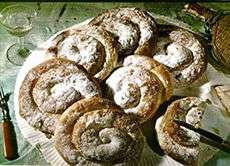Ensaïmada
|
Ensaïmades | |
| Course | Pastry |
|---|---|
| Place of origin | Spain |
| Region or state | Balearic Islands |
| Serving temperature | Cold |
| Main ingredients | Flour, water, sugar, eggs, mother dough, saïm (reduced pork lard) |
|
| |
The ensaïmada (Catalan pronunciation: [ənsə.iˈmaðə], pl. ensaïmades; Spanish: ensaimada) is a pastry product from Mallorca, Spain. It is a common cuisine eaten in most former Spanish territories in Latin America and the Philippines. The first written references to the Majorcan ensaïmada date back to the 17th century. At that time, although wheat flour was mainly used for making bread, there is evidence that this typical pastry product was made for festivals and celebrations.
The ensaïmada de Mallorca is made with strong flour, water, sugar, eggs, mother dough and a kind of reduced pork lard named saïm. The handmade character of the product makes it difficult to give an exact formula, so scales have been established defining the proportion of each ingredient, giving rise to an excellent quality traditional product. The name comes from the Catalan word saïm, which means 'pork lard' (from the Arab word shahim, meaning 'fat').
In Mallorca and Ibiza there is a sweet called greixonera made with ensaïmada pieces left over from the day before.[1]
Variants
Balearic Islands, Spain
Among the variants of ensaimada the most common are:
- Llisa (literally plain) with no extra ingredient.
- Cabell d'àngel (literally angel's hair), the stringy orange strands found inside pumpkins are cooked with sugar to make a sweet filling that is rolled inside the dough.
- Tallades (literally sliced) covered with sobrassada and pumpkin, obtaining a bittersweet taste. It is typical of Carnival days, just before Lent, when meat (including lard and sobrassada) are not supposed to be eaten.
- Crema (literally cream) with cream made with eggs.
- Filled with sweet cream, chocolate or turrón paste.
- Covered with apricot.
Ensaïmades produced far from the Balearic Islands of Spain usually taste very different, mainly because the same kind of reduced pork lard is not used outside these islands or the nearby areas with similar culinary traditions, like Valencia or Catalonia. To tell whether pork lard has been used, if one can't tell by taste, a true ensaïmada must stain a piece of paper with the pork lard (which when heated has a similar texture to oil).
Philippines
The Philippines also adopted the Majorcan ensaïmada (commonly spelled ensaymada in Philippine languages). As a Spanish colony for over 300 years, the Philippine variant has evolved over the centuries and is perhaps one of the most common delicacies in the country. The localized pastry is a brioche baked with butter instead of lard and topped with grated cheese and sugar. Upscale versions of ensaymada can be topped with butter cream and sugar. During Christmas season, it is a tradition to top the pastry with a specially aged type of Edam cheese called queso de bola. It is also customary to eat ensaymada with hot chocolate and strawberries during Christmas. Due to its extreme popularity as a snack across the islands, popular bakeshop chains such as Goldilocks and Red Ribbon also offer ensaymada with their own recipe.
Puerto Rico
In Puerto Rico, another Spanish colony until 1898, the ensaïmada is called Mallorca and is traditionally eaten for breakfast or as an afternoon snack.
References
External links
- The ensaimada Report by MallorcaWeb, in English
- Artisan baker and ensaïmada chef, in English
- General interest about ensaïmadas and vegetarianism, in English
- Traditional ensaïmada recipe Take a taste of Mallorca, in Spanish
- Traditional Ensaimadas of Pampanga, Philippines
- Ensaimada, the sweet temptation Video in English
